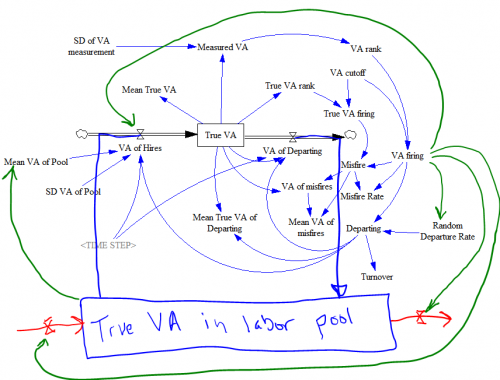In my last post, I showed that culling low-performance teachers can work surprisingly well, even in the presence of noise that’s as large as the signal.
However, that involved two big assumptions: the labor pool of teachers is unlimited with respect to the district’s needs, and there’s no feedback from the evaluation process to teacher quality and retention. Consider the following revised system structure:
In this view, there are several limitations to the idea of firing bad teachers to improve performance:
- Fired teachers don’t just disappear into a cloud; they go back into the teacher labor pool. This means that, as use of VA evaluation increases, the mean quality of the labor pool goes down, making it harder to replace teachers with new and better ones. This is unambiguously a negative (balancing) feedback loop.
- The quality of the labor pool could go up through a similar culling process, but it’s not clear that teacher training institutions can deliver 50% more or better candidates, or that teachers rejected for low value added in one district will leave the pool altogether.
Several effects have ambiguous sign – they help (positive/reinforcing feedback) if the measurement system is seen as fair and attractive to good teachers, but they hurt performance otherwise:
- Increased use of VA changes the voluntary departure rate of teachers from the district, with different effects on good and bad teachers.
- Increased use of VA changes the ease of hiring good teachers.
- Increased use of VA attracts more/better teachers to the labor pool, and reduces attrition from the labor pool.
On balance, I’d guess that these are currently inhibiting performance. Value added measurement is widely perceived as noisy and arbitrary, and biased toward standardized learning goals that aren’t all that valuable or fun to teach to.
- Increasing the rate of departure requires a corresponding increase in the hiring rate, but this is not free, and there’s no guarantee that the labor pool supports it.
There are some additional limiting loops implicit in Out with the bad, in with the good.
Together, I think these effects most likely limit the potential for Value Added hiring/firing decisions to improve performance rather severely, especially given the current resistance to and possible problems with the measurements.


The pool of good and very good teachers is significantly larger than I believe you note. Many of these teachers were let go based on tenure rather than results. No better time to use value-added measurement than in the current recession ! I do believe your analysis is correct when the economy (and the pool of available teachers) is closer to full employment.
Good point. This may be a moment of opportunity. Of course, picking up the good teachers while they’re available assumes that you can tell who they are from resumes & recommendations. Objective measures would make that easier too.
In general I was thinking about the long-term equilibrium, in which case getting bad teachers out of one district isn’t good enough; you have to get them out of the field, and attract new, better replacements in. I doubt there’s that much labor mobility, so using VAM to improve the learning process, making all teachers better, might be more productive.